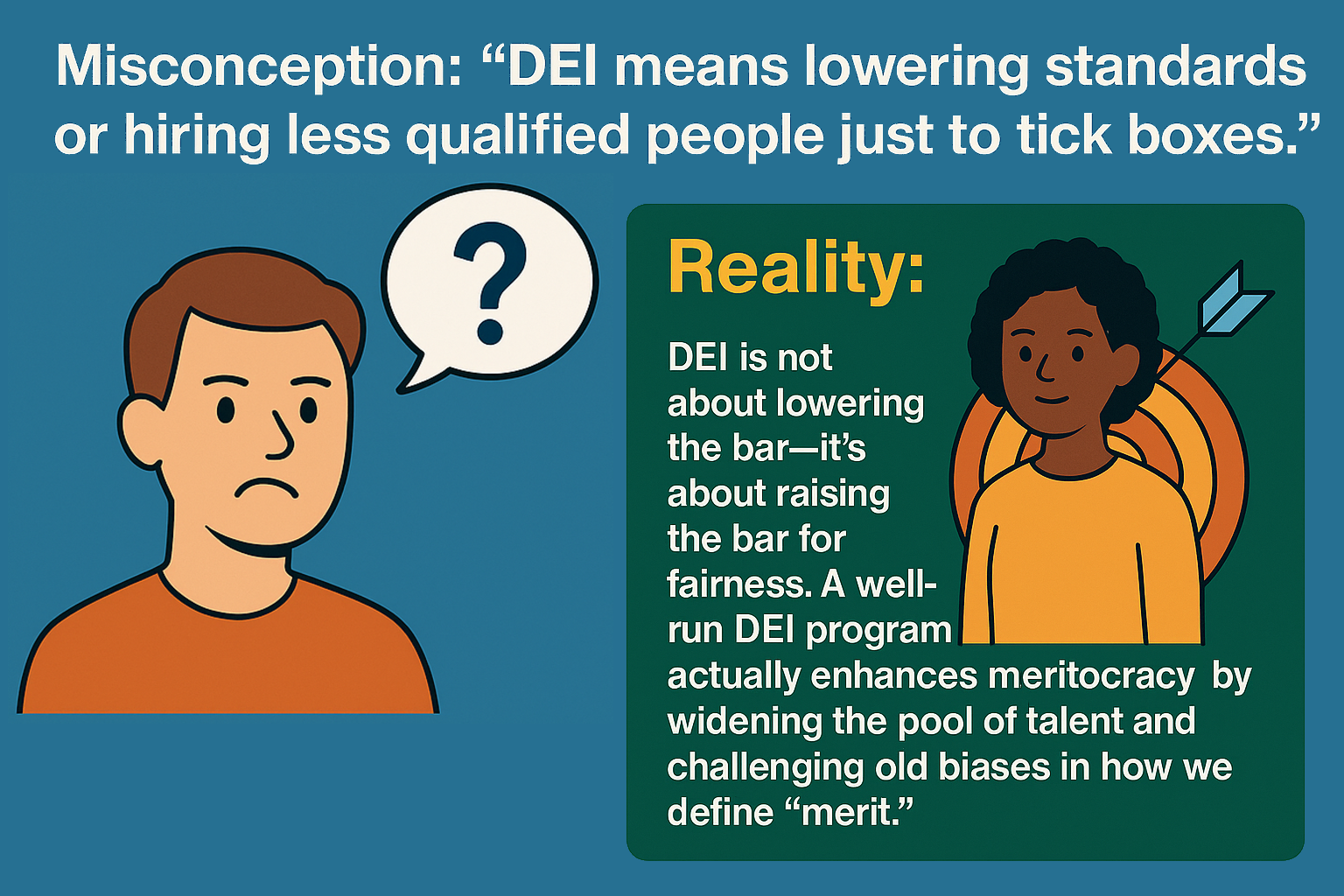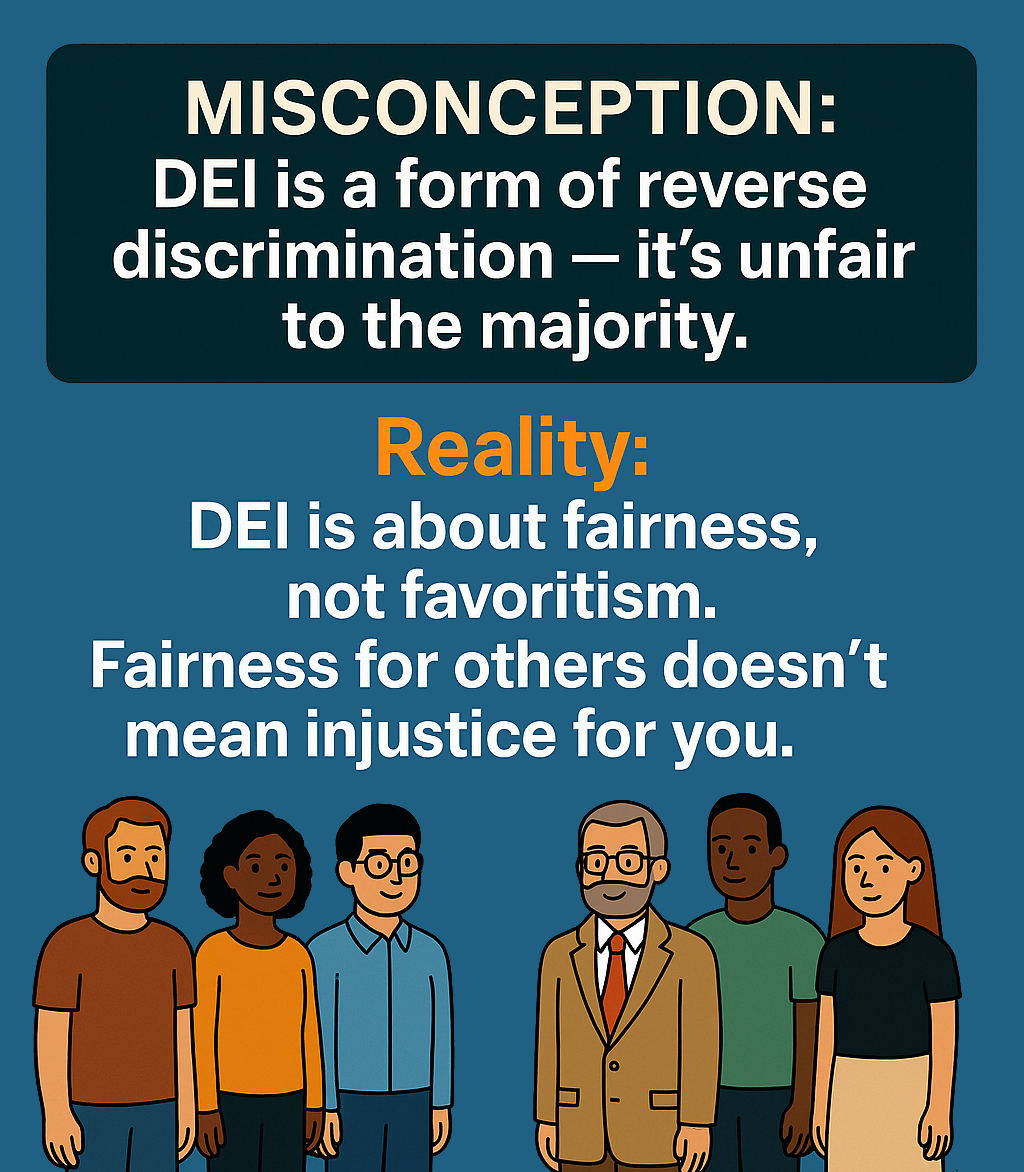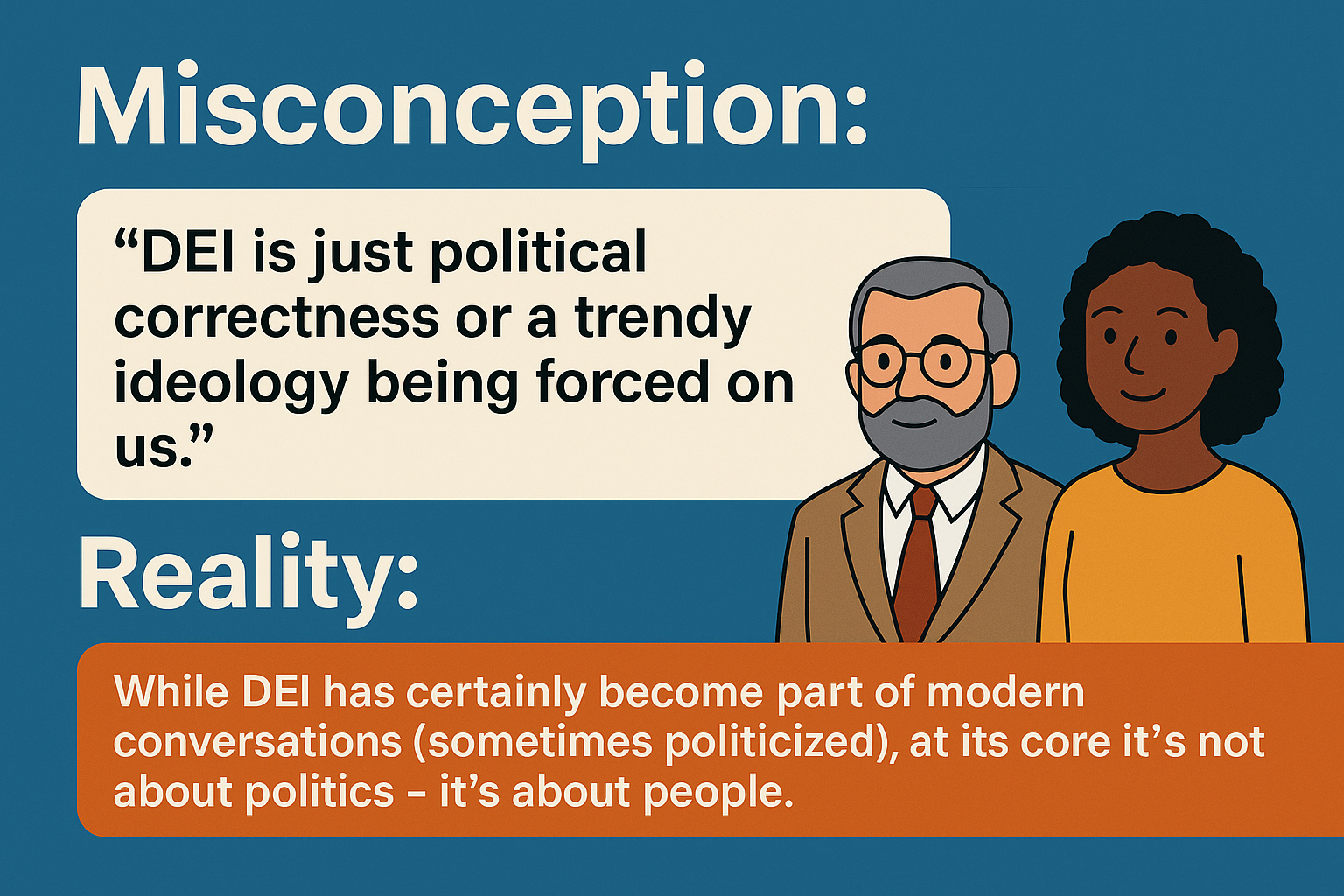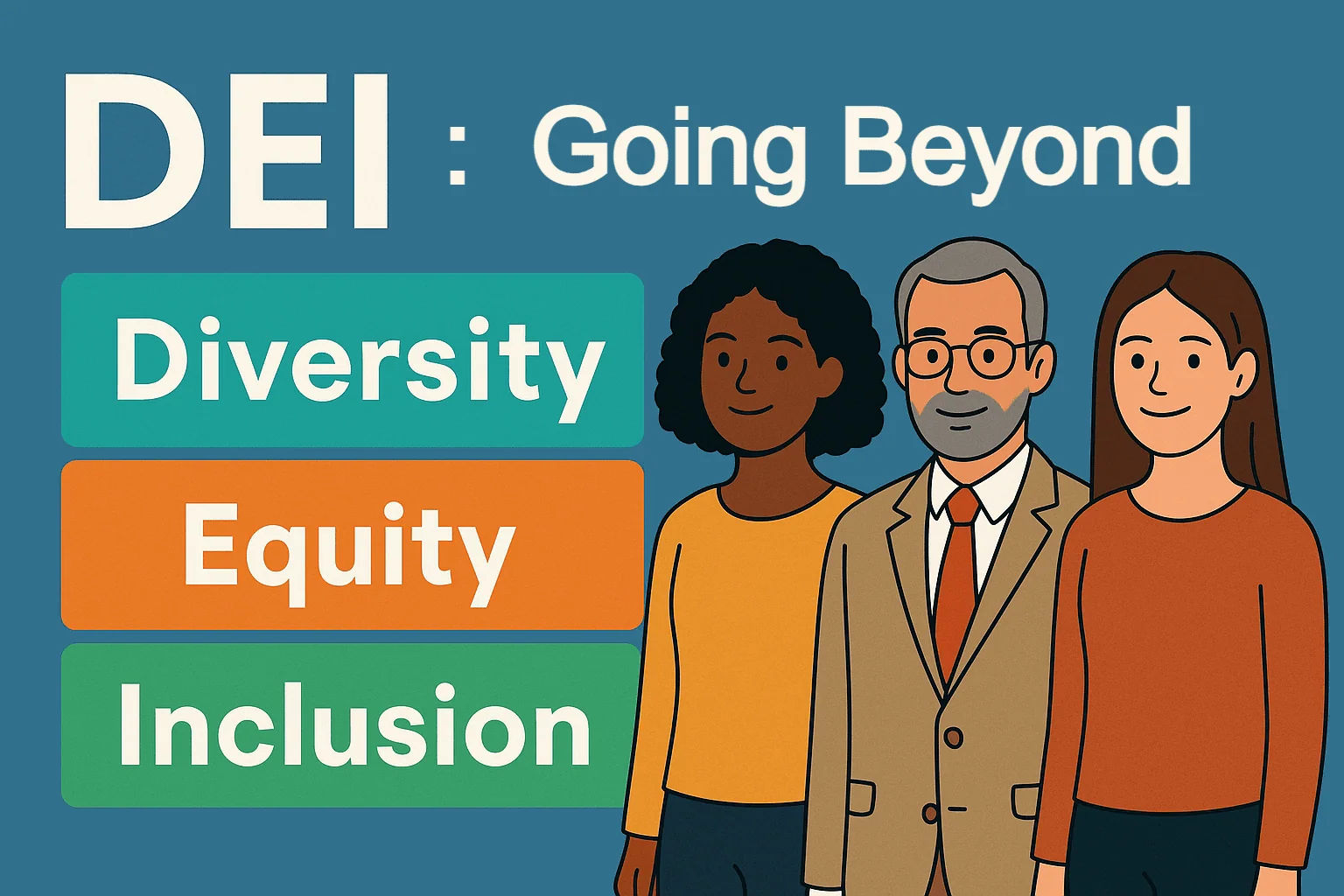The Basics of DEI
By now, we all know DEI is an acronym for Diversity, Equity, and Inclusion. But going beyond that acronym, it symbolizes a much wider vision of how we treat each other and environments where everyone can thrive. The commitment to fairness, respect, and belonging on a human level is DEI in a nutshell. So, what is the symbolic meaning of DEI and why does it matter? Who actually benefits from it? What are some common misconceptions and real examples of DEI in action? How can we all promote these values? Well, keep reading! It’s time to understand what DEI really stands for.
The Meaning Behind DEI
Going a little deeper, Diversity, Equity, and Inclusion is described as:
- Diversity: People from all walks of life in a given setting. Like: having people of different genders, races, religions, ages, abilities, etc.
- Equity: Fairness in access and treatment. Example: realizing that different people may need different support to have an equal opportunity.
- Inclusion: When everyone feels welcome, valued, and able to fully participate. For instance: Give all employees, even remote workers, the same chance/time to speak in meetings.
These three values are very closely linked. It’s not hard to recruit a diverse group of workers, but without the equity and inclusion part, not everyone will perform the same, or even stay.
Sometimes diversity is described as “being invited to the party,” and inclusion is “being asked to dance at that party.” In other words, having variety in the room is one thing, but making sure those diverse voices are heard and included, that is what inclusion is. Equity even goes a step further. It’s like making sure everyone has a way to get to the party and the accommodations they need to have fun. Some have even extended the party metaphor: “equity is making sure everyone has appropriate transport to the dance, recognizing that people start from different locations.” Unlike simple equality (treating everyone the same), equity recognizes that different people may need different resources to reach an equal outcome.
Beyond the definition and metaphors of DEI; it stands for the idea that every person, no matter how they identify or their background, deserves fair treatment and to be included. DEI requires actual actions… enforcing policies, training all staff, employee resource groups, equitable hiring practices, etc. In the heart of DEI, it’s about human dignity and unlocking everyone’s potential. For organizations, specifically, it’s about creating an environment where everyone feels safe to be themselves and to share their ideas and contributions.
Importantly, DEI is not about forcing one ideology or viewpoint. As University of Michigan’s diversity officer Tabbye Chavous put it, “DEI is not an empty phrase or single ideology… DEI efforts include all communities. DEI requires a diversity of perspectives and supports free speech. DEI is integral to [excellence](academic or otherwise).” In other words, true DEI welcomes open dialogue and different opinions under the banner of mutual respect. It’s about expanding the tent, not narrowing it. When done correctly, DEI isn’t a feel-good slogan, it becomes a guiding principle that shapes culture and behavior for the better.
Why DEI Matters
When incorporated right DEI has a significant effect in the workplace and in society. On the job, diversity employment can directly influence an organization’s success. Research has consistently shown that diverse and inclusive companies perform better. For example, companies identified as highly diverse and inclusive are 35% more likely to outperform their competitors financially. Diverse teams also tend to be more innovative and make better decisions, plenty of analysis find diverse teams were up to 87% better at making decisions and much more effective at capturing new markets. The logic is simple: when you bring together people with different perspectives and backgrounds, you reduce “groupthink” and spur creative problem-solving. An inclusive culture lets those ideas surface. In contrast, if everyone on a team has similar experiences, they might approach problems the same way and miss out on fresh solutions.
The Importance of DEI
With DEI there is an obvious link between employees feeling heard and accepted and better employee engagement and higher retention. People are much more satisfied and likely to have a stronger sense of loyalty when they really feel valued and respected at work. A workplace where every employee can see a clear path to success and feels their voice actually counts is the kind of environment that produces trust and motivation. It’s no surprise that in a Glassdoor survey, 69% of executives said diversity and inclusion is an important issue for their organization. Employees do their best work when they can be their authentic selves without fear of bias or exclusion.
DEI Beyond the Workplace
But DEI’s importance isn’t only confined to companies; it matters for society as well. In communities, practicing DEI means creating a sense of belonging for all community members. The difference between a community where certain people or groups of people feel ‘sidelined’ versus one where everyone participates equally is a practical example of DEI in action. When diverse groups, who might not have otherwise talked to each other, come together they can learn new perspectives from one another and build a more empathetic society. Inclusion in schools, government, and public spaces helps make sure that any marginalized groups (such as racial underrepresented groups, people with disabilities, religious groups, etc.) have an equal voice in shaping their community. This in turn, can lead to fairer policies and better outcomes for all. For instance, when city planners use an inclusive approach, they might install curb cuts on sidewalks not only for wheelchair users but also benefiting parents with strollers and older folks, a small example of how inclusive design helps everyone. On a larger scale, reducing systemic inequities (in education, healthcare, justice, etc.) can uplift entire communities and reduce social tensions.
DEI Works for Everyone
In essence, DEI matters because it’s how we create organizations and communities that work for everyone, not just a few. Catalyst, a nonprofit specializing in workplace diversity and inclusion, put it well: DEI done right is the way we create workplaces that work for everyone. By extension, a society that prioritizes DEI will be one where more people can contribute their talents and feel like they belong. When people aren’t held back by prejudice or structural barriers, we all benefit from their ideas and contributions. DEI is about unlocking that potential and correcting imbalances that have excluded people in the past. It’s both a moral imperative, the right thing to do, and a practical one, because our companies and communities thrive when diversity and fairness are front and center.
Who Benefits from DEI?
The short answer: everyone can benefit from DEI efforts. DEI initiatives often focus on supporting underrepresented or disadvantaged groups, for good reasons. But the positive effects actually extend to all members of an organization or community. Let’s break down who gains from a strong DEI culture:

Marginalized and Underrepresented
These are often the most direct beneficiaries. DEI programs might open doors that were previously closed. In a company that is actively working to eliminate bias in promotions, a qualified woman or person of color might now have a more equal shot at that leadership role. In a truly inclusive workplace a person with a disability can find a position that is more willing to provide accommodations or offers more flexible work options. This equals better access to opportunities for people who have historically faced extra hurdles– be it jobs, internships, mentorship, or even career advancement – . In the big picture, DEI helps level the playing field, so success is more about your ability and effort, not what you look like or where you come from.
Majority and Well-Represented Groups
It might sound counterintuitive, but people who are in the “majority” also reap the benefits of DEI. How so? First, inclusivity improves overall workplace culture. Things like respect, camaraderie, and employee well-being go up for everyone, not just the underrepresented. Nobody wants to work in a toxic, discriminatory environment, even if they aren’t the direct target, it’s just not a fun situation. When DEI reduces harassment or bias, everyone can feel safer and more valued. Second, interacting in a diverse team can enhance anyone’s skills – you learn more from colleagues with different perspectives, which can improve your own creativity and adaptability. Third, DEI can dismantle stereotypes that box people in. For example, a male employee in a very inclusive company might feel more free to take paternity leave or express emotions at work, things that rigid gender norms might previously have discouraged. In short, DEI expands what’s acceptable for everyone, allowing all employees to find better work-life balance and personal growth. Even the Iowa State University president (in a somewhat ironic comment while discussing DEI) noted that creating supportive communities benefits “a young white man from rural Iowa” in finding a place to belong. In other words, inclusion isn’t only about helping individuals fit in; it’s about building a culture where any person can find belonging, including those who might feel like an “outsider” for any reason.
Organizations and Teams
When people on a team feel included and fairly treated, the team performs better – this is a well-documented phenomenon. So the organization as a whole benefits in terms of productivity, innovation, and reputation. We touched on the performance stats earlier (like financial outperformance). Additionally, companies known for strong DEI are often seen as employers of choice. They can attract top talent from all backgrounds (including those highly qualified candidates from underrepresented groups). A diverse customer base also appreciates companies that “get it” and represent them. For example, a tech company that hires diversely may design products that appeal to a wider market, because there were different viewpoints in the design room. Or a university that fosters inclusion may see better student outcomes and a stronger alumni network, because more students felt supported. DEI can thus create a virtuous cycle: benefit your people → they do better work → that benefits the organization → which can then further support its people.
Communities and Society
Zooming out, DEI contributes to social equity and harmony. When workplaces are fair, it can reduce economic disparities across society (e.g., narrowing wage gaps). When institutions are inclusive, trust in those institutions increases among different communities. Think of something like policing or healthcare – if those systems actively work on DEI (e.g. hiring officers or doctors from the communities they serve, training in cultural competence, addressing biases), the public is more likely to feel understood and fairly treated, which benefits social stability. Everyone prospers in a society that taps into the full range of talent and perspectives available. We face complex challenges (from business innovation to public health) that are better solved when diverse minds collaborate. DEI helps ensure we’re not leaving valuable knowledge or skills on the table.
In summary, DEI certainly lifts up those who have historically been excluded or undervalued – and that is a core goal. But it’s not a zero-sum game. A rising tide lifts all boats: by creating fairer, more inclusive environments, DEI improves the experience and outcomes for all participants. As one VP of inclusion said about DEI initiatives, “when DEI is done right, it works… [it creates] workplaces that work for everyone.” Whether you’re a minority or in the majority, employee or manager, student or teacher, you benefit when the place you work or live is inclusive and equitable.
Addressing Misconceptions (Empathetically)
Despite the clear benefits, DEI efforts sometimes meet resistance or skepticism. It’s understandable that DEI can involve some uncomfortable changes and can be misrepresented in public discourse. Here are a few common misconceptions about DEI and clarification on them, approaching each concern with empathy and facts:
- Misconception: “DEI means lowering standards or hiring less qualified people just to tick boxes.”
Reality: DEI is not about lowering the bar – it’s about raising the bar for fairness. A well-run DEI program actually enhances meritocracy by widening the pool of talent and challenging old biases in how we define “merit.” For instance, a common argument is that initiatives like affirmative action result in choosing unqualified candidates. In truth, qualified candidates exist in every demographic; DEI helps ensure those people aren’t overlooked. By actively seeking diverse candidates, employers can find the best talent in places they previously weren’t looking. As one commentator put it, if you think diversity and merit are at odds, you’re essentially saying people from diverse backgrounds couldn’t possibly be the most qualified, which is simply not true. In practice, companies often report that adding diversity strengthens their teams and actually boosts quality. A hiring process can be inclusive and rigorous, DEI-focused hiring might use methods like blind resume reviews or diverse interview panels to eliminate bias, but the goal is always to select the most capable person for the job. The difference is everyone gets a fair shot at proving they are that person.

- Misconception: “DEI is a form of reverse discrimination – it’s unfair to the majority.”
Reality: DEI is about fairness, not favoritism. It’s understandable that people in a majority group might feel uneasy, wondering “Does supporting others mean I get pushed down?” Empatically, the aim of DEI is not to exclude or punish any group (no one is calling for “less white people,” despite what some fear). Instead, the focus is on removing unfair barriers that certain groups face. When those barriers come down, it doesn’t mean qualified majority-group individuals suddenly lose their opportunities – it means everyone competes on a more equal footing. Think of it like adding ramps to a building for wheelchair access: those using the stairs aren’t worse off because others can now use the ramp; everyone can still enter, but now more people can do so. Likewise, giving support to an employee resource group for Black employees or women in tech doesn’t take anything away from other employees. It simply provides a space to address specific challenges those groups encounter. When done right, DEI initiatives foster empathy and teamwork across groups, not resentment. In fact, many allies from majority groups become champions of DEI when they see that inclusion creates a better workplace for all. The key is communication: organizations should emphasize that inclusion is not a zero-sum game. Fairness for others doesn’t mean injustice for you, it means everyone is treated with the same respect.

- Misconception: “DEI is just political correctness or a trendy ideology being forced on us.”
Reality: While DEI has certainly become part of modern conversations (sometimes politicized), at its core it’s not about politics it’s about people. Treating colleagues and neighbors with respect and ensuring equal opportunity shouldn’t be a partisan issue. DEI, in practice, is grounded in basic values that most of us share: fairness, respect, dignity, and empathy. It’s true that the terminology and training around DEI have evolved recently (and yes, sometimes buzzwords can feel jargony), but the principles are longstanding. Think of the Golden Rule (“treat others as you want to be treated”) – DEI is an extension of that rule to our diverse society, ensuring we acknowledge and value our differences rather than ignore or suppress them. Moreover, DEI is supported by data and real-world outcomes, not just ideology. Companies aren’t adopting DEI because it’s fashionable; they’re doing it because it leads to better results and because employees and customers expect it. It’s also worth noting that DEI does not require everyone to agree on everything or abandon their beliefs. In fact, a healthy DEI effort welcomes diversity of thought and dialogue. As mentioned earlier, DEI “supports free speech” and a variety of perspectives when done properly. The goal is not to enforce one way of thinking, but to create an environment where no one is marginalized for who they are. If someone feels DEI conversations are too “politically correct,” a good DEI program will invite that person into the conversation, address their concerns, and find common ground. Empathy goes both ways, DEI asks us to listen to those who’ve felt unheard, and also to those who are hesitant, so we can move forward together with understanding.

Of course, there are other misunderstandings (e.g., “We’ve achieved equality already, we don’t need DEI” – which overlooks ongoing disparities; or “DEI is only about race and gender” – which isn’t true, DEI covers all dimensions of diversity including disability, socioeconomic background, veteran status, etc.). In all cases, the approach should be to inform and find empathy. Many people initially resist DEI because they fear change or feel blamed for problems. Successful DEI efforts avoid casting blame on individuals and instead focus on the benefits and positive change for everyone. By sharing facts, success stories, and creating space for dialogue, it’s possible to bring skeptics on board. After all, most people can get behind the idea of a fair shot and a respectful workplace once they see that DEI is about inclusion, not exclusion.
Real-World Examples of DEI in Action
So, what does DEI look like when put into practice? Real-world examples and case studies show us DEI in action:
Inclusive Hiring and Recruitment
A lot of places have changed their hiring practices to attract a more diverse talent pool. Take Salesforce for example, they used data-driven tools to re-analyze their hiring patterns and actually identified biases. It resulted in them revamping their recruitment process, which reportedly saw a 35% increase in hiring candidates from diverse backgrounds. By using “blind” resume reviews and expanding their outreach to formerly underrepresented communities, they found highly qualified people that might have otherwise been overlooked. Equitable practices in hiring, from eliminating bias in interviews to providing accommodations, can actually connect employers with great employees while empowering those employees to shine. It’s a win-win… Candidates get opportunities based on their skills, and companies get dedicated talent.
Diverse Leadership and Decision-Making
Inclusion at the leadership level can transform any organization’s direction. Accenture tracked the performance of all of its teams and saw that the ones with more diversity had 30% better fiscal results, on average. Why? A leadership team that includes people of different genders, ethnicities, and backgrounds is more likely to consider a wider range of risks and opportunities, avoid groupthink, and understand the widely diverse customer base. Take HP Inc., the company loudly declared it would diversify its board of directors and leadership; then, within a few years, they had one of the most diverse boards in the tech industry. It ended up being a major shift in the company’s strategy and performance. Even though many factors contributed to the success, HP’s CEO claimed that having varied voices in the boardroom led to deeper discussions and better decision-making. The key takeaway from these examples is that diversity in leadership is not just about optics… It visibly influences better decisions and business outcomes, creating a positive feedback loop where success reinforces the value of DEI.
Workplace Culture and Access
DEI in action often means creating an inclusive day-to-day culture, where policies and norms consider everyone’s needs. A great example is companies adopting flexible work arrangements and accessibility as standard practice. The COVID-19 pandemic inadvertently taught many organizations that remote work can be very effective; for people with disabilities, the option to work from home or have flexible hours can be a game-changer. Human resources teams that hired people with disabilities did so by embracing remote work, and they ended up with “highly engaged, talented individuals” on their team who simply needed that flexibility to contribute fully. Other aspects of inclusive culture are employee resource groups and mentorship programs.
Companies like Cisco have many ERGs (for women, Black employees, LGBTQ+ employees, veterans, etc.) and they have mentorship initiatives that help underrepresented employees network and advance in their careers. These programs create support systems and give leadership a direct line to hear concerns and ideas from diverse staff. Cisco has reported improvements in retention and employee engagement as a result, which shows how promoting belonging translates to tangible organizational benefits.
Inclusion also means small everyday actions. For example, Microsoft has focused on accessibility not just in products but in meetings – offering real-time captioning in meetings and ensuring events have sign language interpreters. This makes hearing-impaired employees (and even those joining calls in noisy environments) feel included and able to participate.
On the accessibility front, consider physical workspaces. John Deere (the manufacturing company) did a review of its office facilities and made changes like installing mothers’ rooms (for nursing parents), prayer/meditation spaces for employees of various faiths, and gender-neutral restrooms. These changes signaled that all employees are welcome and considered, improving overall morale. While these examples vary, they all reflect a culture where policies and everyday practices are designed with everyone in mind. That’s DEI in action. Not a one-time project, but an ongoing commitment visible in how a place operates.
Each of these cases, hiring diversely, bringing new voices into leadership, and building an inclusive culture, shows a slice of what DEI can look like. They also show that DEI is practical and results-oriented. It’s not just about lofty ideals; it’s about changing processes and habits in ways that support people across different identities and improve outcomes. If you’re a job seeker, hearing these examples might also guide you in what to look for: Does a potential employer have programs for inclusion? Do they celebrate employee differences and make sure everyone can contribute? Real DEI will show up in those ways, not just in a mission statement.

Living DEI Every Day
DEI isn’t only the responsibility of companies or institutions. It takes the actions of every one of us, you don’t need to be a manager or have a special title to make an impact. Here are some actual ways anyone can practice the values of DEI day-to-day:
Use Inclusive Language
How we talk to each other matters more than most realize. A couple small changes in phrasing things can go a long way, and make others feel respected and like they belong. One easy example, try using “partner” instead of assuming someone’s relationship is a “husband or wife” situation. And if you’re not sure how someone identifies or wants to be addressed? It’s okay to ask politely. It also helps to avoid any language that reinforces stereotypes or leaves people out. Think about how you’d feel if someone got your name or pronouns wrong repeatedly. Or worse, if they never even tried to get it right… Giving people credit is another underrated way to make conversations more inclusive. A quick “I really liked Jamal’s point earlier about…” during a meeting isn’t just respectful—it shows you’re paying attention and valuing input. These are little things, sure, but they add up. And when enough people make that effort, it shifts the tone of an entire team or workplace for the better.
Listen and Learn from Others
Make a point to actively listen to people from different backgrounds. True inclusion is about listening to understand, not just respond. This could look like asking a coworker about their cultural holiday and really trying to understand their view. When someone has the courage to share that they feel excluded, it’s necessary to take them seriously… Getting defensive never helps these situations. When you actively listen, you get a deeper learning about others’ perspectives and prove that their voice matters. Additionally, educate yourself. Read books or articles by people of different cultures or attend events (like webinars or community talks) on DEI topics. The more you learn, the better equipped you are to understand and include others. Remember, it’s not the job of marginalized people to educate everyone, taking initiative to learn (via reputable sources, not just assuming or relying on one person) is a key part of practicing DEI.
Welcome People into Your Circles
Think about how you felt the last time you were new in a group or to a job. A friendly welcome or a little extra guidance would make all the difference, right? Well, you can be that friendly face for newcomers. It doesn’t take much… Even just a quick invite to lunch, or dropping them a message to include them in the next group chat can have a bug impact. And if they happen to be one of the only people in the room from their background, that gesture can mean even more. In your personal life, you might realize your friend group or network is pretty ‘homogenous,’ try expanding your circles. Maybe join community activities that introduce you to people of different ages, cultures, or interests. If you’re in a meeting (work or community) and someone quieter or newer hasn’t spoken, consider asking for their input: “I’d love to hear if you have any thoughts, Name.” These gestures help others feel seen and valued.
Act as an Ally
Being an ally isn’t having all the answers or making grand gestures all the time. Allyship can be using your position or privilege to support others who might be facing bias or exclusion. If you notice someone is being interrupted repeatedly in a meeting, step in to pause the discussion: “Hang on, I’d like to hear Maria finish her thought”. Or if you hear a colleague make a joke at the expense of a certain group, an ally might gently speak up and say that those jokes aren’t very funny. Intervene on microaggressions, those subtle slights or biases that occur (like a supervisor always asking the only woman in the room to take notes) they can affect everyone. If one person is always tasked with something like cleaning up after meetings, or If decisions are being made about an underrepresented group that isn’t present, you could say, “Have we considered how this might affect X? Maybe we should get their input first.” In a nutshell, being an ally is using your voice to uplift others who might not be heard. Above all allies actually listen to the groups they support, they amplify the groups voices instead of speaking for or over them.
Examine your own biases and behaviors
None of us are perfect. We all carry biases (usually unconsciously) from our upbringing or social environment. Practicing DEI means doing some introspection. Pay close attention to your immediate reactions… Do you feel uncomfortable around certain people? Do you make assumptions about someone because of how they look or how they speak? Don’t feel guilty, use those introspective moments as opportunities to grow. Challenge those assumptions and push yourself out of your comfort zone. If you come to realize you tend to avoid people because they’re “different” from your usual crowd, make an effort to engage with them. You might even find out how inaccurate your assumptions were. Make sure you are also mindful of ‘knee-jerk comparisons’ or criticisms of different ways of doing things. If a colleague from a different culture approaches a task differently, resist the urge to immediately judge it as “wrong.” You may find it could just be a different approach that works the same or even better. By being self-aware, you can catch yourself in bias and correct course. We all have room to unlearn stereotypes. Think of it as continuous improvement in being a better human.
Support underrepresented voices and businesses
Your everyday choices as a consumer or community member can also reflect DEI values. Consider diversifying where you spend your money or attention. For example, you could support minority-owned businesses… Maybe there’s a family-run restaurant or a shop owned by a person of color in your area you haven’t tried yet. Giving them your business helps promote equity in your local economy. Similarly, get your media from diverse creators: read books by authors of different ethnicities, watch films from different countries, follow social media voices from various communities. This will not only broaden your perspective but also send a message (via market demand) that diverse stories matter. If you happen to select vendors or pick partners, perhaps go with a company that has diverse ownership or vocally supports DEI practices. If you have the means, you could donate to scholarship funds or DEI programs that support underrepresented groups in education, healthcare, or tech. Each of these actions helps to build equity in a wider sense, beyond your immediate circle.
Apologize and Learn from Mistakes
Despite best intentions, we all will slip up at times… and how you handle is what’s most important. Don’t get defensive if someone points out that you were using an outdated term or accidentally used stereotypical language toward someone. Just try to understand where they’re coming from. After, a sincere apology goes a long way: “I’m sorry, I realize now that comment was inappropriate. Thank you for telling me, I will be more mindful going forward.” As the advice often goes, “call in” rather than “call out,” and that applies to you, too. Call yourself in to do better next time. The most common slip-ups are misidentifying someone’s ethnicity through assumptions, asking a woman if she has kids (which could imply that all women do or should), or laughing off a sexist or racist joke instead of calling it in. Even if you catch yourself later on, you can still follow up with the person or that group to clear the air and affirm your commitment to respect. The key is to listen, apologize without caveats, and use it as a teachable moment for yourself. This creates an environment where people know that intent and impact are considered, and that growth is possible. It also models humility – showing others that it’s okay to be wrong and it’s good to learn from it.
By practicing these actions, individuals contribute to a culture of inclusion wherever they go. Remember that small actions, done consistently, make a big difference. For example, consistently inviting the quieter team member to share input can gradually shift the team dynamic to be more inclusive. Or using inclusive language can catch on and become the norm in your friend group or office. DEI values become “real” not just through formal programs but through everyday behavior – basically, through kindness, curiosity, and courage in how we interact with one another.
What DEI Really Means
When you step back and really look at what DEI is about, it’s not just three big words with corporate gloss. It’s a mindset. A way of showing up. It’s choosing to acknowledge that people come from all kinds of backgrounds and making sure those differences don’t get in the way of opportunity or belonging.
For anyone in the workforce, whether you’re just starting out or decades in, understanding DEI helps you see that the best workplaces aren’t the ones with beanbags and buzzwords. They’re the ones where people are seen, respected, and encouraged to be themselves. And creating that kind of environment doesn’t happen by accident. It’s something people choose, every day, in how they listen, who they include, and whether they speak up when it counts.
For leaders DEI means recognizing that diverse teams and inclusive cultures actually make you better at what you do. They challenge assumptions, bring fresh ideas, and reflect the real world outside your office. And for the rest of us… it’s personal ongoing professional development. DEI isn’t some policy in a handbook. It’s in how you treat the new hire. It’s in the way you talk about people who are different from you. It’s in whether you speak up when someone gets talked over or left out. These moments add up.
So, what does DEI stand for? Literally, Diversity, Equity, Inclusion. But symbolically it stands for everything encompassing Dignity, Empathy, and Unity. It stands for a spaces where your unique background is seen as an asset, not a liability. For a society where we lift each other up to equal footing, not knock each other down. DEI stands for everyday acts of inclusion that everyone can do. When we all work together it creates a future where diversity is celebrated, equity is the norm, and inclusion is second nature.




